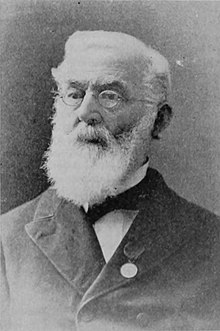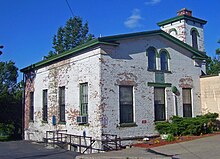James Hall (paleontologist)
James Hall (born September 12, 1811 in Hingham , Massachusetts , † August 7, 1898 in Bethlehem , New Hampshire ) was an American paleontologist and geologist .
Hall studied geology with Amos Eaton and Ebenezer Emmons at the Rensselaer Polytechnic Institute with a master's degree in 1833 and then taught chemistry and geology at Rensselaer Polytec. In 1836 he was part of a multi-year project for the geological survey of New York State , initially as Emmons' assistant. The stratigraphy of the geological layers was determined and named. After finishing work in 1841, he became New York's first state paleontologist. The final report of his district (the land survey was divided into four districts), the fourth in western New York, appeared in 1843. Hall established a laboratory in Albany , now known as the James Hall Office, which is a listed building. Many well-known geologists and paleontologists were trained there, such as Charles Walcott and Charles Emerson Beecher , who were his assistants. In 1866 he became director of the Museum of Natural History of New York in Albany. In 1893 he became a State Geologist of New York. He is buried in Albany.
Hall discovered, among other things, that the stromatolites in the Petrified Sea Gardens in Saratoga Springs are of organic origin.
In addition to his work in New York, he also explored the rest of the United States. In 1850 he took part in the geological survey of Northern Michigan and Wisconsin , where he discovered the first fossil reefs in the USA. He was a state geologist from Iowa from 1855 to 1858 and from Wisconsin from 1857 to 1860.
He was a founding member of the National Academy of Sciences and the first president of the Geological Society of America . He was one of the founders of the International Geological Congress in 1875 and attended its meeting in Paris, Bologna and Berlin and also took part in the 1896 meeting in Saint Petersburg (and an excursion to the Urals ).
In 1848 Hall was elected to the American Academy of Arts and Sciences . Also in 1848 he became a foreign member of the Geological Society of London , whose Wollaston Medal he received in 1858, and in 1884 of the French Académie des Sciences . Since 1854 he was a member of the American Philosophical Society . In 1879 Hall was elected a member of the Leopoldina and in 1885 a corresponding member of the Göttingen Academy of Sciences . In 1895 he became an honorary member of the Russian Academy of Sciences in Saint Petersburg .
His assistant and successor as state palaeontologist was John Mason Clarke .
He is not to be confused with the Scottish geologist James Hall .
Fonts
Hall wrote over 30 books and over 200 scientific papers. Including:
- Geology of New York IV, 1843
- Paleontology of New York, 13 volumes, 1847-1894
- Geology of Iowa, 2 volumes, 1858, 1859
- United States and Mexican Boundary Survey, 1857
Web links
Individual evidence
- ^ Member History: James Hall. American Philosophical Society, accessed September 19, 2018 .
- ↑ Holger Krahnke: The members of the Academy of Sciences in Göttingen 1751-2001 (= Treatises of the Academy of Sciences in Göttingen, Philological-Historical Class. Volume 3, Vol. 246 = Treatises of the Academy of Sciences in Göttingen, Mathematical-Physical Class. Episode 3, vol. 50). Vandenhoeck & Ruprecht, Göttingen 2001, ISBN 3-525-82516-1 , p. 101.
| personal data | |
|---|---|
| SURNAME | Hall, James |
| BRIEF DESCRIPTION | American geologist and paleontologist |
| DATE OF BIRTH | September 12, 1811 |
| PLACE OF BIRTH | Hingham , Massachusetts |
| DATE OF DEATH | August 7, 1898 |
| Place of death | Bethlehem , New Hampshire |

